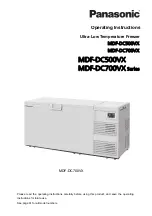
• When shopping, leave frozen food purchases until last
and carry them in a thermally insulated bag.
• On arriving home, immediately place the frozen food in
the appliance.
• Avoid or minimise temperature variations. Observe the
expiry date on the packaging.
• Always follow the storage instructions on frozen food
packages.
Note:
• Eat fully or partially defrosted foods immediately.
Do not refreeze unless the food is cooked after it
has thawed. Once cooked, the food can be refrozen.
• In case of a prolonged power failure: Do not open
the appliance door, except to place ice packs
(if provided) over the frozen foods on the right and
left side of the appliance. This will slow down the
rise in temperature.
PRECAUTIONS AND SUGGESTIONS
• During installation, make sure the appliance does
not damage the power cable.
• Do not store glass containers with liquids inside the
product as they may break.
• Do not eat ice cubes or ice lollies immediately after
taking them out of the appliance as they may cause cold
burns.
• Before carrying out any maintenance or cleaning,
always unplug the appliance or disconnect the power
supply.
• Do not install the appliance in places exposed to
direct sunlight or near heat sources in order to avoid
increasing power consumption.
• Do not put aerosol spray cans or recipients containing
propellants or flammable substances in the appliance.
• Do not store or use gasoline or other flammable liquids
and gases in the vicinity of this or any other domestic
appliance. The fumes can create a fire hazard or
explosion.
• Install the appliance in a perfectly horizontal position, on
a floor strong enough to take its weight and in an area
suitable for its size and use.
• Install the appliance in a dry, well-ventilated place.
The appliance is set for operation at specific ambient
temperature ranges, according to the climatic class
indicated on the data plate located at the rear of the
product (Fig. 7). The appliance may not work properly
if it is left for a long time at a temperature outside the
specified range.
• It is advisable to leave the appliance connected if left
empty even for short periods.
• Be careful not to damage the floors when you move the
appliance (e.g. parquet). To facilitate product handling,
it is advisable to empty it beforehand, if possible.
Note:
The appliance must be handled and installed by two
or more persons.
• Do not use mechanical devices or any means other
than those recommended and/or supplied by the
manufacturer to speed up the defrosting process.
• Do not use electrical appliances inside the product,
unless such appliances are specifically recommended
by the manufacturer.
• The bulb used inside the appliance is specifically
designed for domestic appliances and is not suitable for
general room lighting within the home (EC Regulation
244/2009).
• This appliance must not be used by children under
8 years of age, or by people with limited physical,
sensory or mental abilities or without experience
and knowledge of it, unless instructed in its use by
those responsible for their safety.
• Do not allow children to play or hide inside the
product: risk of becoming trapped inside and
suffocating.
• Power cable modification or replacement must only
be carried out by qualified personnel or After-sales
Service.
• Do not use extension leads or adapters.
• Electrical disconnection must be possible either by
unplugging the appliance or by means of a double-
pole switch located upline from the socket.
• Ensure that the voltage indicated on the appliance
data plate corresponds to the domestic supply
voltage.
• Do not ingest the contents (non-toxic) of the ice
packs (if provided).
• Restrict the number of times you open the door.
• This appliance features “skin condenser”
technology: the condensing unit is integrated into
the walls of the freezer. For this reason the side
and front walls of the product may become hot
while the product is running. This is entirely normal
and also reduces the risk of condensation forming
in particularly critical environmental conditions
(see paragraph “Troubleshooting guide”).
APPLIANCE DEFROSTING
The appliance should be defrosted when the thickness of
ice on the walls reaches 5-6 mm.
• Disconnect the appliance from the power supply.
• Remove food from the appliance and put it in a very
cool place or a thermally insulated bag.
• Leave the appliance door open.
• Remove the internal defrost water drain plug (depending
on model) (Fig. 8).
• Remove the external defrost water drain plug
(depending on model) and reposition it as shown in
fig. 8.
• Use the separator (depending on model) inside the
product as a recipient for any remaining water, (D) as
shown in fig. 8. If there is no separator, use a shallow
container.
• Defrosting can be sped up by using a spatula to detach
the frost from the appliance walls.
• Remove the frost from the bottom of the appliance.
• In order to avoid permanent damage to the
appliance interior, do not use pointed or sharp
metal instruments to remove the ice.
• Do not use abrasive products or heat up the
interior artificially.
• Dry the inside of the appliance thoroughly.
• Refit the plug after defrosting.
























